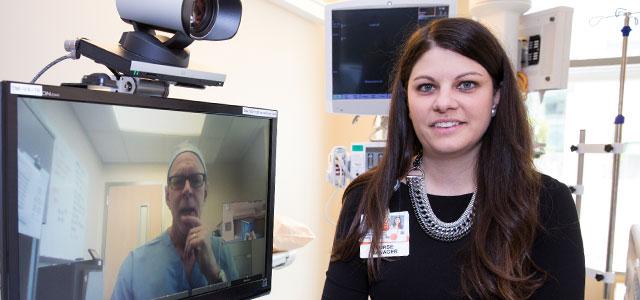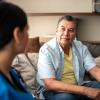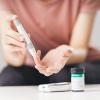
Tristin Penland readies the telehealth cart for a dermatology consult (photos by Elisabeth Fall).
Nurses Help UCSF Explore the Role of Telehealth
Because telehealth technology can make world-leading expertise more widely available, UCSF Medical Center has launched a number of telehealth initiatives for both internal and external use.
One such initiative aims to speed consultations for inpatients at the new Mission Bay hospitals, when these patients’ clinical situation requires a consult with a specialist whose primary caseload remains across town at the Parnassus campus.
“For defined clinical situations, rather than have a physician travel for 30 minutes, we now have telehealth carts that have a high-resolution camera, a microphone, a digital stethoscope and other tools,” says Linda Branagan, director of Telehealth Programs at UCSF Medical Center.
She emphasizes that nurses play a crucial role in telehealth at UCSF, from coordinating the consultation to helping define workflows and processes so the medical center can optimize the use of this technology.
“Nurses are the local hands and eyes and ears,” says Branagan. “This is definitely a new role, and they are taking to it quite well.” She credits Tristin Penland, patient care manager for the Mission Bay clinical resource team, as being instrumental in the program’s early successes.
Applying the Learning
Penland is a recent graduate of UC San Francisco School of Nursing’s Master of Science in Healthcare Administration and Interprofessional Leadership (MS-HAIL) program, where she completed a project focused on why telehealth appeared to be underused.
“That work opened my eyes to how we could use it more, as well as to some of the challenges and why people can be resistant to it,” Penland says.
 Penland uses the handheld camera while a magnified image of the patient’s hand is displayed on-screen. She was involved when the medical center began experimenting with telehealth in 2014, with pilot programs for defined consults in labor and delivery, critical care, neurology and cardiology. Each one of the four services had a champion, and each consulting service created its own parameters. “We found it worked fairly well,” says Penland.
Penland uses the handheld camera while a magnified image of the patient’s hand is displayed on-screen. She was involved when the medical center began experimenting with telehealth in 2014, with pilot programs for defined consults in labor and delivery, critical care, neurology and cardiology. Each one of the four services had a champion, and each consulting service created its own parameters. “We found it worked fairly well,” says Penland.
Once some of these services moved to the new hospitals at Mission Bay, Penland was part of the team that refined the parameters for consults as use of the telehealth carts expanded to other services.
How It Works
Dermatology offers a clear-cut example of how the process works.
When a patient develops a rash of unknown origin, the nurse will call in the hospitalist. If the hospitalist determines there’s a need for a dermatology consult, the nurse will contact Penland’s team to arrange the consult.
Before the consult, Penland’s nursing team rolls the cart into the patient’s room. The provider calls in, and the nurse uses the handheld camera to supply a magnified picture of the rash. Typically, Penland’s team handles the cart, though labor and delivery has its own cohort of trained nurses.
The process is similar for other types of consults, though the tools might be different. For cardiology, for example, nurses use the stethoscope to allow cardiologists to hear heart tones; and for neurology, the camera conveys patients’ eyes and reflexes.
“By rolling in the cart, we give the provider the ability to be in the room, instead of just on the phone,” says Penland.
Overcoming Challenges
In addition to her work managing the telehealth consults, Penland serves as the liaison with the medical center’s telehealth team to identify any concerns, whether it’s teams needing more training, workflow challenges or spots in the hospital where the Wi-Fi doesn’t work.
Despite these challenges, Penland says the more she uses the carts, the more she believes they have real clinical value. She and Branagan are working to identify other use cases.
“Maybe we’d want to consult with a neuro-ICU clinical nurse specialist about whether or not we have a drain set up right or if a patient’s pupils look uneven,” says Penland.
The catch is that it’s not easy to break old habits, and clinical teams don’t always use the carts when they might be appropriate. She is working with Branagan to address this through various forms of communication and education.
“We’ve found that once clinicians find a champion within their own specialty, the resistance usually goes away,” she says.



